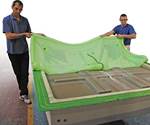RVB Infusion = Light RTM?
There is some difference of opinion as to whether parts infused under reusable vacuum bags (RVBs) are the equivalent of those produced by Light resin transfer molding (RTM). See why.
There is some difference of opinion as to whether parts infused under reusable vacuum bags (RVBs) are the equivalent of those produced by Light resin transfer molding (LRTM). Arlington Heights, Ill.-based Composites One’s RVB expert Ashley Duncan says no. Like Light RTM, RVB infusion eliminates styrene emissions and reduces cycle time, but a sprayed RVB alone typically does not provide an engineered B-side finish: “If you need a gel coat finish on the B-side,” she says, “then a semirigid or rigid countermold is the solution.”
But Torr Technologies’ (Auburn, Wash.) president Greg Lindstrom asserts that in his experience autoclave-worthy silicone sheet goods can be processed to provide a cosmetic B-side, up to and including a Class A finish.
Rich Rydin of RVB system provider SR Composites LLC (Henderson, Nev.), however, has advocated for several years the use of a “floating caul plate” under the flexible membrane to achieve two-sided cosmetic parts as an alternative to Light RTM. Alan Harper (Alan Harper Composites Ltd. (Saltash, Cornwall, U.K.) adds that an RVB’s very high elongation and flexibility allows for variation in layup schedules, permits higher reinforcement loading than Light RTM and costs less than a rigid B-side mold.
Related Content
-
Otto Aviation launches Phantom 3500 business jet with all-composite airframe from Leonardo
Promising 60% less fuel burn and 90% less emissions using SAF, the super-laminar flow design with windowless fuselage will be built using RTM in Florida facility with certification slated for 2030.
-
ASCEND program completion: Transforming the U.K.'s high-rate composites manufacturing capability
GKN Aerospace, McLaren Automotive and U.K. partners chart the final chapter of the 4-year, £39.6 million ASCEND program, which accomplished significant progress in high-rate production, Industry 4.0 and sustainable composites manufacturing.
-
All-recycled, needle-punched nonwoven CFRP slashes carbon footprint of Formula 2 seat
Dallara and Tenowo collaborate to produce a race-ready Formula 2 seat using recycled carbon fiber, reducing CO2 emissions by 97.5% compared to virgin materials.


